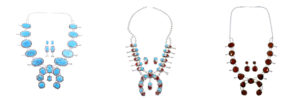You may have seen these beautifully ornate and intricately designed necklaces somewhere before but they have a much richer history than you might have suspected. The origin of squash blossom necklaces actually came from Spain and many other cultures to boot. From the Paleolithic period to Phoenician culture, the crescent shape that you see today in modern fashion has likewise represented different things.
Worn by the goddess of fertility, Astarte and adorned by the Romans, this symbol has captivated the hearts and minds of cultures across the world, spanning many centuries.
Native Americans came upon the design from Spain. The earliest trace of Spain using the Squash Blossom (Naja) is during the middle ages, when the Moors occupied Spain for eight centuries.
The Moors would make these necklaces for their horses to wear during battle. They believed this ancient symbol would protect both the rider and their horse from harm.
When the Spaniards traveled to the new world, centuries later, they brought this design and concept with them. During this time, traders taught the Native Americans to work with silver and other metals to produce new and more stunning works of art as a way of trade.
Taking from this inspiration, the Native Americans began to make squash blossom necklaces for their tribesman to wear when most tribes shifted from a warrior society to a merchant and trading system.
 It’s been noted that the design serves no ceremonial or spiritual purpose but is regarded highly in Navajo society due to the skill required to make them.
It’s been noted that the design serves no ceremonial or spiritual purpose but is regarded highly in Navajo society due to the skill required to make them.
Today, most of the Native American squash blossom necklaces are made by the Navajo tribe and can be found along the Southwest. Native artists typically use turquoise and sterling silver to make their pieces, using these ancient techniques that have been passed down from one generation to the next.
I’ve provided a few examples so you can see the detail that goes into making one. Most Native American jewelry takes from nature to produce magnificent pieces like the ones featured here. As you can see, one of them is made from turquoise (a common element of Native jewelry), but there are many other routes artists can take. Amber is another beautiful example, as well as coral.
Some artists even incorporate symbols within the necklace to imbue them with their own beliefs. The coral and turquoise necklace below is made with the snake symbol, which often means good health and rejuvenation in Native culture.
This facet of Southwest and Native American fashion have become the standard for top-tier jewelry and will continue to last because of the quality material, design, and detail that go into each piece.
I think it’s worthy to note the unique history of the squash blossom necklace too. You never know just how deep a symbol can be until you pull up your sleeves and get to work.


